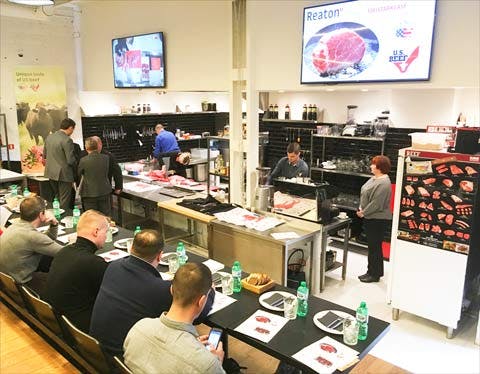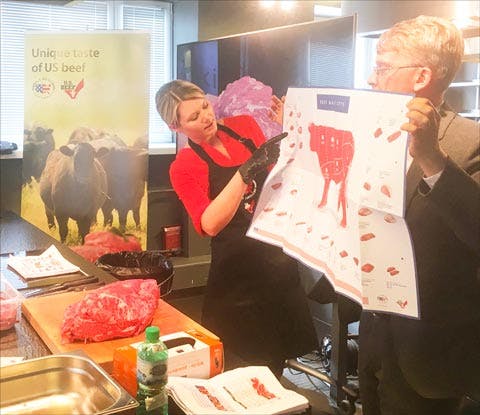USMEF Showcases Alternative Cuts of U.S. Beef in Baltic Region
Working to overcome pricing and competitive challenges in the Baltic region, USMEF recently conducted U.S. beef master classes to demonstrate new ideas for utilizing both premium and alternative cuts. The classes in the Baltic countries of Latvia, Lithuania and Estonia – along with one in Finland – were funded by the Beef Checkoff Program and designed to engage importers and HRI professionals on the attributes that set U.S. beef apart from competitors’ products.


“The goal of the beef master classes is to illustrate different methods of muscle utilization and break them down using various cuts, whether for grilling or roasting, ” said Cheyenne McEndaffer, USMEF technical services manager. “The Baltics are part of the European Union and any beef coming out of the U.S., because of the production protocol we have to follow, is more expensive. Our importers in the European Union have to buy full sets because of the high cost of non-hormone treated beef that we send, so it’s important that they are able to maximize the value of every cut.”
Yuri Barutkin, USMEF representative in the region, led the master classes with McEndaffer. He explained that USMEF has worked with HRI distributors in the Baltics to convince them to include U.S. beef in their regular import portfolios. The master classes were a joint effort with Reaton, one of the largest HRI distributors in the region.

The U.S. beef master class in Latvia featured detailed looks at alternative cuts that fit well in the market
“U.S. beef is available in all three Baltic countries, but its presence on retail shelves and restaurant menus has been rather nominal,” said Barutkin. “The absence is due in part to the higher production cost of non-hormone treated beef, but also because these markets have been overlooked by large importers of U.S. beef in Europe.”

McEndaffer and USMEF Representative Yuri Barutkin gave participants in Estonia detailed information on U.S. beef cuts and how to use them
Cutting demonstrations at all three master classes were performed by McEndaffer, who covered in detail the technical aspects of each alternative cut. She focused primarily on the versatility of the cuts, as well as the consistency, quality and profitability. Barutkin explained U.S. beef production practices and feeding techniques – including those employed in non-hormone treated beef production.
USMEF identified alternative cuts such as U.S. beef chuck roll, top sirloin and shoulder clod – along with classic ribeye – as cuts that have potential for success in the Baltics, where consumers tend to have little disposable income.
“We’re looking for restaurants that will feature these cuts so we have an outlet for round and chuck cuts, along with the middle meats sold at retail,” said McEndaffer, noting the pricing challenge U.S. beef must overcome. “Our competitors in Europe are not only domestic beef, but also Uruguayan and Australian beef. U.S. beef is generally more expensive than these products, but we bring other unique attributes to the table that are showcased in these master classes.”
Participants were able to taste steaks derived from U.S. beef alternative cuts and make their own judgements about the quality of U.S. beef. Baseball steaks, Denver cut steaks, Sierra cut steaks, Ranch steaks, Delmonico steaks and boneless country style ribs were featured in the demonstrations, along with roast options.
A similar cutting demonstration was also performed in Helsinki, Finland, in partnership with distributor Bergfalk Oy.
“The level of disposable income in Finland is very different than in the Baltics, as Finland has one of the highest disposable incomes in the world,” said Barutkin. “But alternative cuts also have a place in Finnish restaurants, if we take the right approach to the market. Finnish consumers are much more focused on supporting local production and tend to be less receptive to imported products, including beef, so this presents a challenge.”
Developing new markets within the European Union continues to be a USMEF goal.
“We feel that by diversifying and expanding the number of distributors and wholesalers working with U.S. beef we can expand usage in Europe, winning market share from our competitors in Australia and South America,” said Barutkin.
Additional photos and videos from the master classes are available at www.USA-BEEF.org.
